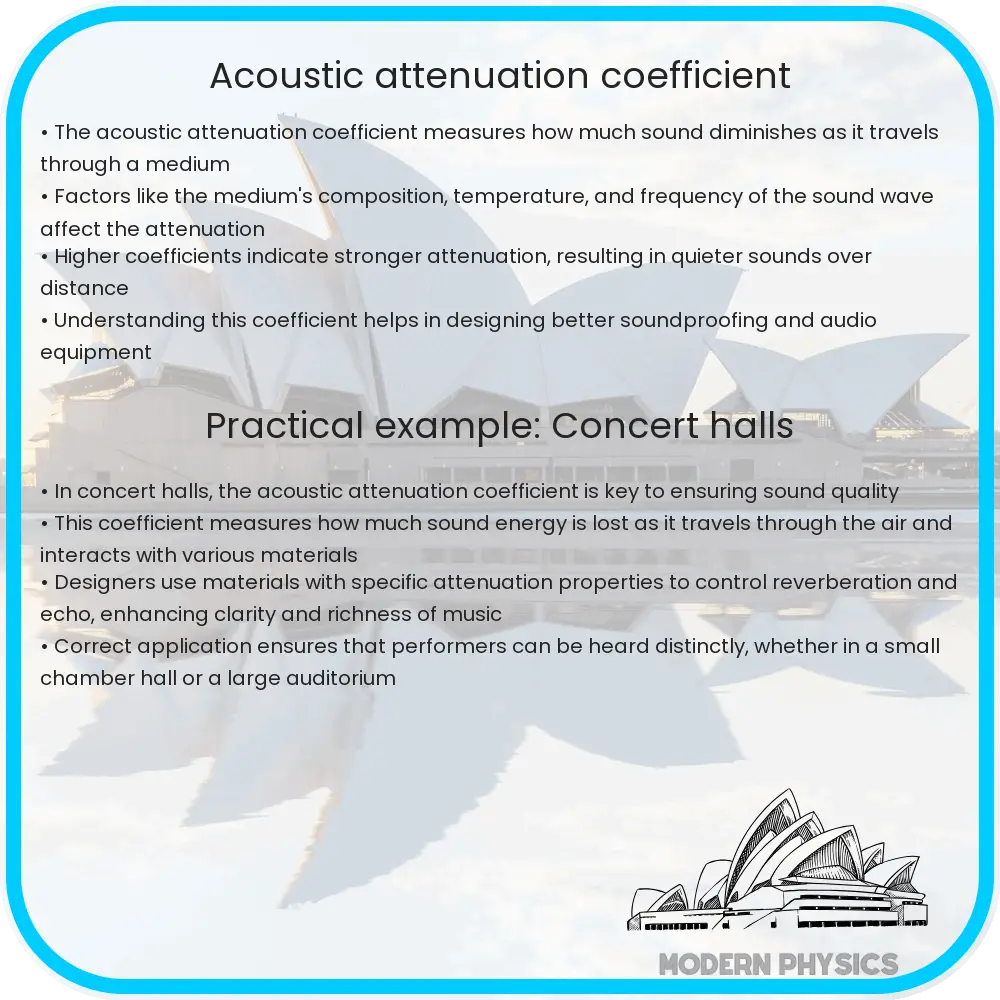Learn about the acoustic attenuation coefficient, a critical parameter that quantifies sound wave amplitude reduction in various media, impacting fields from engineering to medical imaging.

Understanding Acoustic Attenuation Coefficient
Acoustic attenuation is a fundamental concept in physics that describes how the amplitude of sound waves decreases as they propagate through a medium. The attenuation coefficient, often denoted as alpha (α), is a key parameter in quantifying this loss. It provides vital insight into how sound energy is absorbed or scattered, impacting everything from acoustic engineering to medical ultrasound imaging.
Measurement of Acoustic Attenuation Coefficient
The attenuation coefficient is typically measured in units of decibels per meter (dB/m) and can be determined using several methods depending on the medium and the frequency of the sound. One common method involves measuring the reduction in sound intensity as it travels through a known distance in the medium. The formula to calculate α is:
α = (1/d) * 10 * log10(I₀/I)
Where:
- d is the distance the sound wave has traveled through the medium.
- I₀ is the initial sound intensity.
- I is the sound intensity after traveling distance d.
In labs, precise instruments such as hydrophones for underwater sound, or microphones in air, are used to measure these intensities. This setup is often combined with signal processing tools to ensure that measurements are unaffected by background noise or reflections.
Importance of Acoustic Attenuation Coefficient
Understanding and controlling acoustic attenuation is crucial in various fields. In medical imaging, especially ultrasound, attenuation affects the depth of penetration of the sound waves and the quality of the image. Engineers designing concert halls, recording studios, and other acoustically sensitive environments rely on knowledge of acoustic attenuation to optimize sound quality and clarity.
In environmental science, studying sound propagation in the ocean can help in monitoring animal communication and navigation, as well as human-induced noise pollution. Each application relies on accurate knowledge of the attenuation coefficient to predict and manipulate how sound travels through different environments.
Applications of Acoustic Attenuation Coefficient
The practical applications of the acoustic attenuation coefficient are broad and impactful:
- Medical Imaging: In ultrasound technology, attenuation coefficients help in adjusting the ultrasound machine settings to improve the contrast and resolution of an image, adapting for different depths and types of body tissues.
- Architectural Acoustics: In building design, understanding the acoustic properties of materials can lead to better sound insulation and acoustics in buildings. This is crucial for theaters, auditoriums, and residential buildings.
- Underwater Acoustics: For marine biologists and oceanographers, the attenuation coefficient is essential for understanding how sound propagates in water, affecting communication among marine life and the impact of human activities on the aquatic environment.
- Noise Control: Engineers use attenuation coefficients to design barriers, absorbers, and other noise control applications to manage and reduce undesirable noise in various environments.
The versatility in the applications of the acoustic attenuation coefficient highlights its importance across different disciplines and sectors. By accurately measuring and utilizing this coefficient, professionals can make informed decisions in design, diagnostics, and environmental management.
Factors Influencing Acoustic Attenuation
The degree of attenuation can vary significantly depending on several factors:
- Medium Composition: Different materials absorb and transmit sound differently. For example, sound waves travel differently through air, water, and solids.
- Frequency of Sound: Generally, higher frequencies are more susceptible to attenuation. This is why lower frequencies are used for longer-range communication in marine environments.
- Temperature: Temperature changes can affect the density and elasticity of a medium, thereby influencing sound propagation.
- Humidity: In gaseous environments, higher humidity can enhance sound attenuation due to the increased density of the medium.
Understanding these factors is crucial for accurately predicting and managing sound behavior in various applications.
Challenges in Measuring Acoustic Attenuation
While the measurement of the attenuation coefficient is straightforward in theory, practical challenges can arise:
- Environmental Noise: Accurate measurement requires isolation from ambient noise, which can interfere with results.
- Reflections and Scatterings: In irregular or complex environments, sound waves can bounce off surfaces or scatter, complicating the measurement process.
- Equipment Calibration: Precise and regular calibration of measuring instruments is necessary to ensure reliable results.
Overcoming these challenges requires careful experimental design and advanced technological solutions to obtain accurate and reliable data.
Conclusion
The concept of acoustic attenuation and its coefficient, α, plays a pivotal role across various scientific and engineering disciplines. From enhancing the clarity of medical images to aiding in the design of acoustically optimized buildings, the applications of this parameter highlight its importance. Understanding the factors influencing sound attenuation and the methods of its measurement allows professionals to predict and adjust for variations in sound propagation effectively. As technologies evolve, the precision in measuring and manipulating sound qualities can only enhance the applications further, making acoustic attenuation a continually relevant and essential field of study in physics and engineering.
